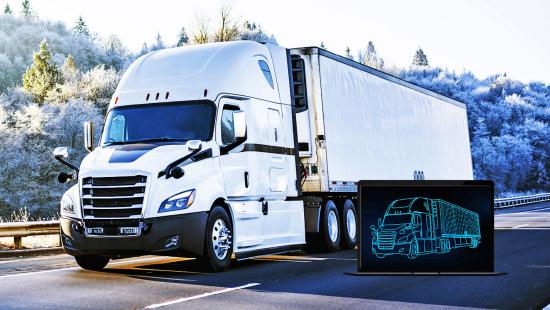Costs for a complete shipper TMS
Transportation Management Systems (TMS) continue to be one of the largest areas of IT investment for shippers who want to gain better visibility, control, and reduce costs in their supply chains. The costs for a complete shipper TMS including features like; carrier connectivity (messaging, real-time visibility, etc.) will vary widely depending on a range of factors such as the number of shipments, the freight modes in scope, and the functionalities needed.
With virtually all TMS vendors now offering software as a service (SaaS) structured pricing, long gone are the days of high software purchase prices, implementation costs, and annual on-going maintenance fees. Today, the shipper TMS costs can be split into two main groups that align more with the effort to support the solution (implementation/training costs) and the usage of the TMS (transaction-based recurring costs). In this article we’ll focus primarily on the recurring costs and the common structures that vendors charge for using the TMS.
Generally, shipper TMS recurring pricing models fall into one of the following categories:
Price per shipment
The most common model for a shipper TMS is transaction based, using the number of shipments planned and executed through the system. The transaction-based model offers scalability, as the cost is directly tied to the usage and workload of the shipper. It allows companies to pay for the TMS based on their actual transportation volumes, but typically with some minimum shipment volume that is inversely correlated with the size of the transaction fee (as volume increases, the transaction fee decreases).
The fee per shipment often varies per mode, the required features in the solution, and is dependent on the total shipment volume. For example, a company with 1,000 shipments per year will be paying a higher per shipment fee than a company with 1 million shipments per year. Transaction fees can range from twenty-five cents to several dollars/euros per shipment depending on volume.
Alternative transaction pricing
In this situation, the pricing is based on the number of documents and/or messages per shipment. The price range per document or message can be between one cent or a few cents per transaction, which is a seemingly low price. However, a shipment will often trigger several or dozens of messages and documents.
This can drastically increase the total cost and makes it difficult to budget for. This pricing model is often much more expensive than anticipated. Performing due diligence with your vendor to benchmark the expected message count can help budget for the costs, but as technology and regulations change, so can the message/document count.
License-based pricing
Under this model, the company purchases a license for the TMS software, which is typically a one-time upfront cost plus ongoing annual maintenance fees. The license cost can range from tens of thousands, to millions of dollars/euros depending on the scale and sophistication of the TMS. However, as mentioned previously, with virtually all modern TMS solutions being SaaS, this model is hardly used anymore.
Carrier/LSP paid
Some vendors offer a low, or no cost, TMS that is subsidized by the carriers and brokers that move the freight for the shippers. In this case the TMS provider, in addition to funneling volume to their LSP partners, may also share the overall shipment data they have within their system. The feature set provided by these solutions is limited by design and the freight costs may not be as competitive as what may be available in the market. This is primarily an option for very low-volume shippers.
Freemium pricing
This is also a low, or no cost, TMS solution that provides a very basic set of features for low-volume shippers. The TMS vendor is betting that as the shipper grows, they will migrate into their premium version (with fees) of the TMS. Additionally, the TMS vendor may also make a margin on each shipment/load moved through their system with their preferred carriers/brokers. In this case, shippers should be sure they understand if there is a markup on the freight costs and the fees and capabilities in the premium version to ensure they align with the shipper’s expectations for where their business is going.
A complete shipper TMS covers the full scope of requirements, but some necessary features in todays’ transportation operations are not offered by all TMS providers, and even if they are, they typically have additional fees for the added value provided. Shippers should understand the additional costs and capabilities of the following features, at a minimum, when evaluating a TMS.
- Check if automated carrier communication (connectivity/messaging via EDI and API) is included in the fees. Many TMS vendors, including SAP and Oracle, have API connectivity but do not necessarily offer EDI/API connections with all carriers in all modes. This connectivity may be required outside of the TMS for an additional cost.
- If your TMS also includes real-time visibility embedded from the TMS vendor, that should be made clear in the transactional price for your TMS. But if you are buying visibility via an external visibility partner, you need to make sure you understand that additional cost for tracking.
- Full parcel shipping capabilities are not in the ‘wheelhouse’ of all leading TMS vendors. Several TMS providers (including SAP and Oracle) do not have a full parcel shipping solution. For shippers with significant parcel freight that are looking for multi-carrier rate shopping, or label printing, you may need an external solution to manage this freight if you choose a TMS that does not provide it. This means you will get an additional recurring fee and potentially added integration/implementation fees.
Additional fees
In addition to transaction fees, shippers need to be aware of how the TMS vendor treats customer service (help desk) issues. All TMS vendors include ‘standard’ support as part of their subscription fees, but the definition of what is ‘standard’ can vary widely between vendors. There are many instances documented in online reviews where shippers contact their TMS help desk with what they think is a ‘bug’. The users are then told they will need to pay an hourly fee to have the functionality changed or pay to create a workflow to make the system behave as the shipper wants. No TMS provider can deliver any ‘wish-list’ item at no cost, but through customer references shippers can get a better idea of how easy it is to work with TMS vendors on support issues.
No matter the pricing logic utilized by the TMS vendor, shippers should do their homework on understanding how the fees align with their business and what is included in the fees or requires additional subscriptions. If the TMS provider does not cover your full scope, you should request additional vendors to provide pricing to fill in the gaps.
For shippers with different modes and geographies there may be savings from contracting with a single TMS provider. As stated earlier, the more volume you manage through a TMS the lower the transaction fees. Aside from the benefit from lower fees from a single TMS vendor, there is also a real benefit for shippers in contracting with a single TMS provider in not having to worry about integrations and data fidelity issues between systems. Plus, coordinating customer service from a single TMS provider across modes and geographies makes the on-going experience significantly better.
I hope you found this article insightful, and it will help you to find the best shipper TMS for your business. At Descartes we are passionate about logistics and support our global customers with our modern, complete, and leading shipper TMS.

TMS Buyers Guide
Explore the comprehensive guide to select the ideal Transportation Management System for enterprise shippers.

Transportation Management Solutions
Global Transportation Technology to Strengthen Your Supply Chain



